Coal in Australia
Coal is mined in every state of Australia. The largest black coal resources occur in Queensland and New South Wales.[1] About 70% of coal mined in Australia is exported, mostly to eastern Asia,[2] and of the balance most is used in electricity generation. In 2019-20 Australia exported 390 Mt of coal (177 Mt metallurgical coal and 213 Mt thermal coal) and was the world's largest exporter of metallurgical coal and second largest exporter of thermal coal.[3] While only employing 50,000 mining jobs nationally coal provides a rich revenue stream for governments.[4]
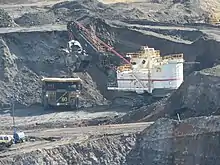
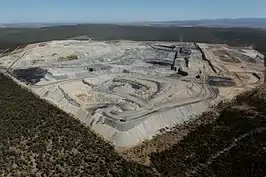
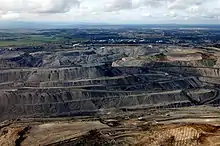
Coal mining in Australia has been criticized,[5][6] due to carbon dioxide emissions during combustion. This criticism is primarily directed at thermal coal, for its connection to coal-fired power stations as a major source of carbon dioxide emissions, and the link to climate change in Australia and worldwide.[7] Coal was responsible for 30% (164 million tonnes) of Australia's greenhouse gas (GHG) emissions, not counting methane and export coal, in 2019.[8] Coal as a fuel was responsible for 41% (160 million tonnes) of carbon dioxide emissions in Australia in 2020.[8]
The Carbon Pollution Reduction Scheme, which followed the draft report in the Garnaut Climate Change Review, placed a price on carbon emissions through a reducing cap and trade emissions trading scheme and incentivised against carbon pollution temporarily, before it was revoked in 2014. Despite a target to reduce GHG emissions Australia continues to open new coal mines.[9]
Forms of coal
Australian coal is either high-quality bituminous coal (black coal) or lower-quality lignite (brown coal).[10]
Bituminous coal is mined in Queensland and New South Wales. It is used for both domestic power generation and is exported. Mining is underground or open-cut. The coal is transported by rail to power stations or export shipping terminals.[11][12]
Lignite is mined in Victoria and South Australia,[13] and is of lower quality due to a lower thermal value largely caused by a high water content.[14] Ash content varies significantly but some Australian lignites have relatively low ash content.[15] In 2013 coal from three open cut lignite coal mines in Victoria was used for power generation.[13]
History

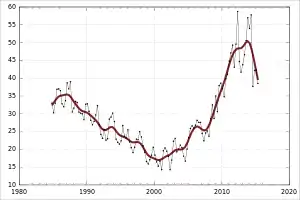
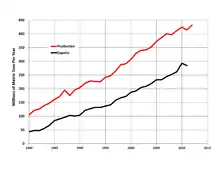
Australian coal was first discovered in New South Wales by shipwreck survivors in August 1797, at Coalcliff, north of Wollongong. George Bass discovered coal soon afterwards in the cliffs at Newcastle off of Point Solander.[16][17] Coal exports first left Newcastle in 1799,[18] with it being mined by convicts. Shipments left for India, marking Australia's first commodity export.[19] Mining in the area was initially small scale and used in domestic heating.[20]
In Queensland, coal mining began near Ipswich in 1825.[21] The following year coal was discovered at Cape Paterson in Victoria.[22] It wasn't until the 1850s that the deposits were mined, however it wasn't enough to sustain Victorian communities.[23] Coal was discovered in Tasmania at Plunkett Point in 1833.[24] In Western Australia, the first coal deposits were discovered in 1846 at Irwin River in what is known as the Coalseam Conservation Park.[22]
By the 1900s coal had become integral to the economy as it was used in locomotives on railways and in steam mills cutting logs, and grinding wheat.[20] In New South Wales development was particularly influenced by coal during the 20th century.[25] During the 1940s Australian coal mines experienced significant strikes.[20] The 1949 Australian coal strike lasted for seven weeks. The Joint Coal Board was formed to aid in the resolution of workers' disputes. Before WWII underground mines dominated. After WWII, Australia began exporting coking coal to Japan to aid in their production of steel.[20] Exports to South Korea and Taiwan soon followed. Australia became the number one coal exporter in 1984.[26] By 1986 Australia was supplying around half of all its exports to Japan.[26] As the Bowen Basin Coalfields were developed, open-cut mines became more common.[20] From the 1980s onwards the ratio of thermal coal exported to Asia increased significantly.[20] High-grade coking coal extracted from the Illawarra region has supported a steel and steel products market with exports leaving via Port Kembla harbour.[19] An anti-coal movement is a recent historical development.[25]
Production, exports and reserves
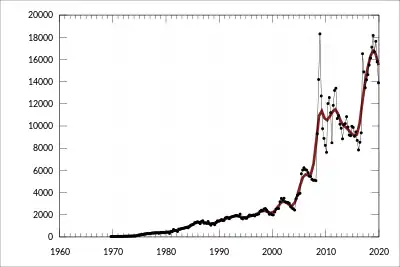
In 2016, Australia was the biggest net exporter of coal, with 32% of global exports (389 Mt out of 1,213 Mt total). It was the fourth-highest producer with 6.9% of global production (503 Mt out of 7,269 Mt total). 77% of production was exported (389 Mt out of 503 Mt total).[27]
At the end of 2019, Australia earned $63.9 billion from black coal.[22] The value of Australian coal exports reached $112 billion in the 2021-22 financial year.[28] This was the second time a commodity had reached $100 billion in exports for Australia, after iron ore.
Major export markets for Australian coal
.jpg.webp)
Australia exports the largest share of coal of any nation, at 54% of the total.[29] In 2020, exports of coal accounted for 1% of national revenue, with a total value of A$55 billion.[30]
| Country/area | Million tonnes coking | Million tonnes steaming | Million tonnes total | Rank | % of exports |
|---|---|---|---|---|---|
| Japan | 35.8 | 81.0 | 116.8 | 1 | 30.0 |
| China | 39.6 | 49.8 | 89.4 | 2 | 23.1 |
| India | 45.3 | 4.8 | 50.1 | 3 | 13.0 |
| Other | 30.3 | 19.5 | 49.8 | 4 | 12.9 |
| Korea (ROK) | 17.8 | 30.1 | 47.9 | 5 | 12.4 |
| Taiwan | 10.0 | 22.5 | 32.5 | 6 | 8.4 |
| Total | 178.8 | 207.7 | 386.5 |
Major coal export ports
The Port of Newcastle, New South Wales, is the world's largest and most efficient coal handling operation through its two terminals: Carrington and Kooragang. Australia has nine major coal-export ports,[32] including:
| Port | State | Million tonnes 2009 |
Million tonnes 2008 |
|---|---|---|---|
| Newcastle[33] | NSW | 92.8 | 91.4 |
| Hay Point[34] | QLD | 82.4 | 80.4 |
| Gladstone[35] | QLD | 56.2 | 54.1 |
| Abbot Point[34] | QLD | 14.4 | 12.5 |
| Port Kembla[36] | NSW | 13.7 | 13.3 |
| Brisbane[35] | QLD | 6.3 | 5.5 |
| Total | 265.8 | 257.2 |
Major coal mining companies

The largest coal producers in Australia are BHP, Glencore, Yancoal, Peabody, Anglo American and Whitehaven Coal.[37] As at June 2023, coal companies in Australia were making windfall profits due to the Russian invasion of Ukraine.[38]
Future planned coal mining
Several new coal mines are planned for development in Australia. This includes Olive Downs mine, to be operated by Pembroke Resources, near Coppabella, Queensland.[39] In 2021, the federal government agreed to loan the project A$175 million to begin the first stages of its development.[40] In April 2022, the construction of the mine commenced. Production is expected to begin in 2023.[41]
Divestment from coal
Several mines have announced plans to wind-down operations in coal within set timeframes, alongside planned closures of coal power plants in Australia. This includes Werris Creek (2025).[42]
In 2016, Glencore announced that Tahmoor Colliery would be closed by 2019.[43] However, Glencore later sold the mine to SIMEC in 2018,[44][45] who still operate it.
BHP planned to sell the Mount Arthur mine in 2022, but failed to attract a viable offer and decided to continue operations there until financial year 2030.[46]
In August 2022, BHP completed its sale of the BHP Mitsui Coal to Stanmore Resources.[47]
Banks such as Westpac have introduced restrictions on lending for new thermal coal mines, including a limit of 6,300 kilocalories per kilogram for new projects.[48] By 2021, Australia' big four banks were committed to leaving thermal coal by 2030, pledging alignment with the Paris Climate Agreement.[49]
Environmental impacts
.jpg.webp)
Both underground and open-cut mines generate significant environmental impacts, including modified topography, soil erosion, water pollution, air pollution and acid water drainage.[50] The coal industry claims that extensive rehabilitation of areas mined helps to ensure that land capability, after coal mining, meets agreed and appropriate standards.[51][52]
Coal is the principal fossil fuel used in power generation not only in Australia but in many other countries. Links between coal mining, coal burning, and climate change are being discussed widely in Australia.[53][54]
On 27 November 2006 the Land and Environment Court of New South Wales judge Justice Nicola Pain made the decision to set aside the Director-General's acceptance of the Environmental Assessment for the Anvil Hill coal mine,[55] on the grounds that it did not include a comprehensive greenhouse gas assessment, even though the proposed mining of coal was for export. However, on 7 June 2007 the planning minister for NSW Frank Sartor reversed this decision and approved the mine, attaching a list of 80 conditions to the mines operation including conservation offsets.[56]
An international climate think tank produced a report that concluded Australia's coal mines are emitting twice as much methane as national estimates, finding a massive under-reporting of methane emissions in Australia.[57] As part of the nation's commitment to the Paris Agreement Australia must reduce its emissions by 26–28% in 2030 compared to 2005. According to the International Energy Agency, no new coal projects or gas projects can be approved if the world is to achieve net zero emissions by 2050.[58]
Protests against coal
One of the first protests against coal development occurred to the south of Sydney in the early 1970s. Clutha Development wanted to build a new coal loading facility at Coalcliff.[59] Coal was to be stored in heaps along the coast. Local activist, Judy Gjedsted, organised protests which successfully ended the proposal.[59]
In November 2021, anti-coal protestors led by Blockade Australia disrupted activity at the world’s largest coal terminal, the Port of Newcastle, by abseilling from equipment and obstructing railway tracks. The protests lasted for 10 days and 17 people were arrested.[60][61] Coordinated action by Blockade Australia in June 2023 saw ports in Newcastle, Brisbane and Melbourne targeted.[62] In April 2023, about 50 people caused a train loaded with coal to come to a halt at Newcastle.[63] Some of the protestors then climbed on top of a carriage loaded with coal, remaining there for almost three hours.[63]
The Carmichael mine run by Adani Group, planned since 2012 and opened in 2021, drew national and international opposition, both from climate activists and traditional owners.[64][65] In August 2019, the government extinguished 1,385 hectares of Wangan and Jaggalingou native title in order to grant Adani title to the land.[66] Protestor activity at the mine has included 40 people blocking the entrance of the mine, with two chaining themselves to a drum of reinforced concrete.[67]
Environmental regulation of coal mining
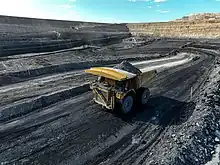
The Australian commonwealth government is responsible for making policy on off-shore exploration of coal and resources, while the governments of the states and territories are responsible for policy on onshore exploration.[68]
Commonwealth law
The main Commonwealth environmental laws potentially applicable to coal mining are the Environment Protection and Biodiversity Conservation Act 1999 (EPBC Act) and the Clean Energy Act 2011. The EPBC Act is triggered if a proposed action is likely to have a significant impact on a matter of national environmental significance, for example federally listed threatened species and groundwater impacts.[69]
In September 2022, the Australian Parliament passed the Climate Change Bill. It includes the national targets of cutting emissions by at least 43% by 2030 (compared with 2005) and reaching net zero by 2050.[70] The bill is largely symbolic, it doesn't stipulate how the country will get to its targets.
New South Wales
Relevant laws are mining law, land use planning law, biodiversity law and water law.
Pollution law
Coal mining requires a pollution control ('environment protection') licence under the Protection of the Environment Operations Act 1997 (NSW) if it exceeds the following thresholds set out in Schedule 1 of the Act: if it is mining, processing or handling of coal (including tailings and chitter) at underground mines or open cut mines and (a) it has a capacity to produce more than 500 tonnes of coal per day, or (b) it has disturbed, is disturbing or will disturb a total surface area of more than 4 hectares of land by: (i) clearing or excavating, or (ii) constructing dams, ponds, drains, roads, railways or conveyors, or (iii) storing or depositing overburden or coal (including tailings and chitter).[71]
Queensland
In March 2020, the Queensland Resources Council introduced safety protocols to promote the health of coal mine workers amidst the international spread of COVID-19. These included improvements to social distancing of workers, disallowing visitors from the public to enter the sites and checking the temperature of workers at mine site entries.[72]
See also
References
- "Coal". Australian government Geoscience Australia. 29 May 2014. Retrieved 27 March 2020.
- "Coal". Government of South Australia Energy Mining. March 2020. Retrieved 27 March 2020.
- Australian Government (2020). Resources and Energy Quarterly December 2020 (PDF). pp. 15, 41, 52.
- Toscano, Nick; Foley, Mike (27 September 2021). "It's a $50b-a-year export industry. How long until coal's rivers of gold run dry?". The Sydney Morning Herald. Retrieved 27 September 2023.
- The Greens NSW (July 2011). "Coal and Coal Seam Gas Policy". Archived from the original on 5 February 2014. Retrieved 15 June 2020.
- Greens Queensland (19 February 2017). "Upper Hunter Valley coal mining shows dangers for Queensland". Archived from the original on 19 February 2017. Retrieved 20 May 2023.
- Preston, B.L.; Jones, R.N. "Climate Change Impacts on Australia and the Benefits of Early Action to Reduce Global Greenhouse Gas Emissions" (PDF). CSIRO. Archived from the original (PDF) on 25 February 2009. Retrieved 23 January 2013.
- Ritchie, Hannah; Roser, Max (11 May 2020). "CO₂ and Greenhouse Gas Emissions". Our World in Data.
- "Australia passes a law to reduce emissions, at last". The Economist. ISSN 0013-0613. Retrieved 19 October 2022.
- "Coal". Data & Publications. Australian Government. Archived from the original on 4 January 2019. Retrieved 9 May 2019.
- "Coal Geology". Science Topics. Australian Government. 15 May 2014. Archived from the original on 25 July 2019. Retrieved 15 August 2019.
- "Coal transport infrastructure development". Queensland Government. 24 August 2017. Archived from the original on 1 April 2019. Retrieved 15 August 2019.
- Geoscience Australia (2013). "Coal - Geoscience Australia". Australia's Mineral Resource Assessment 2013. Australian Government. Archived from the original on 1 March 2018. Retrieved 18 September 2018.
- "Lignite/ Brown Coal". Victoria State Government. Department of Jobs, Precincts and Regions, Victoria, Australia. 4 March 2016. Archived from the original on 6 July 2018. Retrieved 8 January 2019.
...its high moisture content - which ranges from 48-70 per cent - reduces its effective energy content
- Durie, R. "THE CHARACTERISTICS OF AUSTRALIAN COALS AND THEIR IMPLICATIONS IN COAL LIQUEFACTION" (PDF). R.W. Miller & Co. Pty. Ltd. Archived (PDF) from the original on 28 April 2017. Retrieved 8 January 2019.
These coals differ from the Tertiary brown coals of North America in that they have a much lower ash yield...
- Knibbs (1910). "Non-Metallic Minerals". Official Year Book of the Commonwealth of Australia No. 3 1910. Collins Street, Melbourne: McCarron, Bird & Co. p. 515.
- Power, Frederick (1912). "Chapter IV, New South Wales". Coalfields & Collieries of Australia. Sydney: Critchley Parker. p. 60.
- Carabott, Mike (28 March 2022). "The historical role of coal in Australia and the National Energy Grid". Leading Edge Energy. Retrieved 17 October 2022.
- "Mining History". NSW Minerals Council. Retrieved 17 October 2022.
- Quince, Annabelle (1 October 2015). "What future for coal, a crucial part of Australian history?". ABC News. Australian Broadcasting Corporation. Retrieved 17 October 2022.
- "Coal". Geoscience Australia. Retrieved 17 October 2022.
- "Coal". Geoscience Australia. Retrieved 27 September 2023.
- "Coal - Powering Victoria". Earth Resources. Government of Victoria. 2 June 2021. Retrieved 17 October 2022.
- "History". Coal Mining History Site. Retrieved 17 October 2022.
- Bosca, Hannah Della; Gillespie, Josephine (September 2018). "The coal story: Generational coal mining communities and strategies of energy transition in Australia". Energy Policy. 120: 734–740. doi:10.1016/j.enpol.2018.04.032. S2CID 158491150. Retrieved 17 October 2022.
- Owen, A.D. (April 1988). "Australia's role as an energy exporter: Status and prospects". Energy Policy. 16 (2): 131–151. doi:10.1016/0301-4215(88)90121-8. Retrieved 17 October 2022.
- IEA Key World Energy Statistics 2017 (PDF). International Energy Agency. 2017. p. 17. Archived (PDF) from the original on 7 July 2018.
- Saunders, Matt; Campbell, Rod (December 2022). "From Russia with Love – Coal profits due to the war in Ukraine" (PDF). Australia Institute. Retrieved 27 September 2023.
- "Coal Mining in Australia". PIMS Group. Retrieved 18 October 2022.
- "Climate change: Why Australia refuses to give up coal". BBC News. 22 October 2021. Retrieved 18 October 2022.
- "Coal in India 2019" (PDF). Australia Office of the Chief Economist. 2019. p. 51. Retrieved 20 April 2021.
- Minerals Council of Australia, Australia's Coal Industry - Ports and Transport
- "Archived copy". Archived from the original on 6 July 2011. Retrieved 14 February 2010.
{{cite web}}: CS1 maint: archived copy as title (link) - http://www.transport.qld.gov.au/resources/file/eb3e0c4a36b1d25/Pdf_port_of_abbot_point_cape_flattery.pdf%5B%5D
- http://www.transport.qld.gov.au/resources/file/eb3dff4a36695d1/Pdf_coal_metals.pdf%5B%5D
- "Trade & Cargo". Port Kembla Port Corporation. Retrieved 23 January 2013.
- Morton, Adam (1 November 2019). "Coal from six biggest miners in Australia produces more emissions than entire economy". The Guardian. Retrieved 27 September 2023.
- Antrobus, Blake (14 January 2023). "Report reveals Aussie coal exporters' staggering $45B gain amid Russian invasion of Ukraine". news.com.au. Nationwide News. Retrieved 21 June 2023.
- Pembroke Resources. "Olive Downs Coking Coal Complex". Retrieved 13 August 2019.
- "Federal Government to loan Olive Downs coal mine project near Moranbah $175m". ABC News (Australia). 1 July 2021.
- Casey, Jessica. "Pembroke Resources Breaks Ground at Olive Downs". World Coal. Retrieved 8 April 2022.
- "Australian coal output to remain flat in 2022, mainly due to scheduled closures". Mining Technology. 27 July 2022. Retrieved 18 October 2022.
- "Glencore to close Tahmoor coal mine". Deutsche Welle. 2 June 2016. Retrieved 18 October 2021.
- Tahmoor SIMEC Group
- Creagh, Ben (3 January 2018). "Glencore offloads Tahmoor coal mine to GFG Alliance". Australian Mining. Retrieved 11 December 2018.
- "BHP Abandons Thermal Coal Exit as Investors and Prices Shift". Bloomberg. 16 June 2022. Retrieved 18 October 2022.
- "BHP Abandons Thermal Coal Exit as Investors and Prices Shift". Australian Mining. 15 August 2022. Retrieved 18 October 2022.
- "Westpac rules out Adani Carmichael coal loan". Australian Financial Review. Fairfax Media. 28 April 2017. Retrieved 18 October 2022.
- Grieve, Charlotte (20 May 2021). "Big four banks forced to defend thermal coal exit". The Sydney Morning Herald. Retrieved 27 September 2023.
- De Valck, J., Williams, G., & Kuik, S. (2021). Does coal mining benefit local communities in the long run? A sustainability perspective on regional Queensland, Australia. Resources Policy, 71, 102009. doi:10.1016/j.resourpol.2021.10
- "Reducing the Environmental Impacts of Coal Mining". Archived from the original on 7 April 2007.
- Lock the Gate Alliance (23 March 2016). Wright, Ian (ed.). "Free-loaders : air and water pollution from NSW coal mines". Lock the Gate Alliance. Archived from the original on 14 December 2022. Retrieved 25 February 2023.
- "Australian coal mine blocked over climate impact". New Scientist. 1 December 2006. Retrieved 23 January 2013.
- Scott Bevan (2 November 2006). "Climate concerns fuel coal mine opposition campaign". 7:30 Report. Australian Broadcasting Corporation. Retrieved 23 January 2013.
- "Australian Judge Blocks Coal Mine on Climate Grounds". Steel Guru. 3 December 2006. Retrieved 16 August 2019.
- "NSW Govt approves Anvil Hill coal mine". ABC News. Australian Broadcasting Corporation. 7 June 2007. Retrieved 23 January 2013.
- Morris, Nathan (8 June 2022). "Australia's total coal mine methane emissions double official estimates, Ember report finds". ABC News. Australian Broadcasting Corporation. Retrieved 28 September 2023.
- Slezak, Michael (29 July 2021). "NSW coal mine approvals could undo work on net-zero emissions targets, analysis suggests". ABC News. Australian Broadcasting Corporation. Retrieved 28 September 2023.
- Simon Leo, Brown; Craney, Anna (3 December 2020). "The Australian anti-coal campaign that took on 'the world's richest man' and won". ABC News. Australian Broadcasting Corporation. Retrieved 18 October 2022.
- "Protesters disrupt the world's largest coal port: 'This is us responding to the climate crisis'". The Washington Post. 17 November 2021. Retrieved 18 October 2022.
- "Coal export protesters blasted by Barnaby Joyce with claims of $60 million lost in exports in past 10 days". ABC News. Australian Broadcasting Corporation. 15 November 2021. Retrieved 18 October 2022.
- "Climate protesters block coal shipments in three states as Minns warns against 'dangerous' situations". The Guardian. 19 June 2023. Retrieved 28 September 2023.
- Cook, Carly (16 April 2023). "Anti-coal mine protesters stop coal train in Newcastle, dozens arrested". ABC News. Australian Broadcasting Corporation. Retrieved 28 September 2023.
- "Opponents fume as Adani celebrates first coal export from Carmichael Mine". ABC News. 29 December 2021. Retrieved 11 November 2022.
- "Adani is poised to ship its first coal – is this failure for Australia's defining climate campaign?". the Guardian. 17 December 2021. Retrieved 11 November 2022.
- "Queensland extinguishes native title over Indigenous land to make way for Adani coalmine". the Guardian. 31 August 2019. Retrieved 11 November 2022.
- "Adani protesters charged after 'chaining themselves to concrete drum'". www.9news.com.au. Retrieved 11 November 2022.
- "Legislation, regulations and guidelines". 21 March 2020. Retrieved 18 October 2022.
- "Coal and coal seam gas - Regulation". Department of Climate Change, Energy, the Environment and Water. Retrieved 18 October 2022.
- Morton, Adam (8 September 2022). "Australian parliament passes first climate change legislation in a decade". The Guardian. Retrieved 27 September 2023.
- Protection Of The Environment Operations Act 1997 - Schedule 1. New South Wales Consolidated Acts. AustLII. Retrieved 2013-01-23.
- "Qld coal mining companies swing into action on COVID-19". www.miningmonthly.com. 21 March 2020. Retrieved 23 March 2020.
External links
- "Illawarra Coal" - An unofficial history of coal mining in the Illawarra
- Survey of Energy Resources 2007 for Australia
